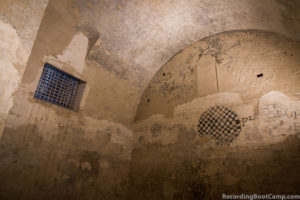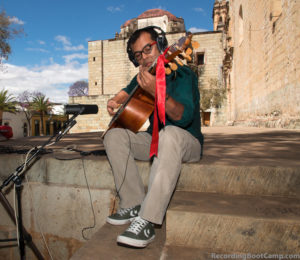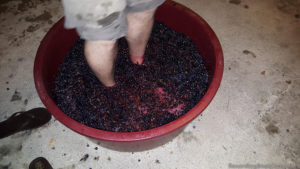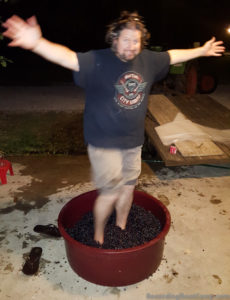I just finished another awesome 6-day Recording Boot Camp in Italy with students from Italy, Sweden and Austria. I am taking some time off this week to enjoy Italy. The last few days I have been exploring the Emilia-Romagna region seeing lots of amazing spaces in churches, castles and palazzi. Of course, because I am an audio geek and in love with sound, I am walking around clapping and making clicking noises to listen to reverb tails of these fantastic rooms (or pretending to cough in places where I needed to be more discreet).
 One stand out room was “Don Giulio’s dungeon and torture chamber” in Castello Estense (Ferrara, Italy). While I am sure that this was a terrible place to spend time in the 1500s, the reverb tails in that room were amazing!!!! I was wishing I had some way to make some impulse responses. (speaking of impulse responses, we have added an impulse response workshop to the Recording Retreat this May).
One stand out room was “Don Giulio’s dungeon and torture chamber” in Castello Estense (Ferrara, Italy). While I am sure that this was a terrible place to spend time in the 1500s, the reverb tails in that room were amazing!!!! I was wishing I had some way to make some impulse responses. (speaking of impulse responses, we have added an impulse response workshop to the Recording Retreat this May).
All this listening to spaces reminded me of a good questions someone sent me last month. They wrote and asked:
“When I am recording in a bad sounding space, should I be close miking everything?”
That is a really good question, but one that does not have a super simple answer. Obviously, the closer our mic is to the sound source, the more the direct to ambient balance will favor the sound source as opposed to your bad sounding room. But moving a mic closer to the sound source is not always “a free lunch”, meaning that there might be some things about close miking that may not always sound great. When we close mic with many mics we need to start dealing with proximity effect (that unnatural build up of low frequency energy with directional mics). If the sound source moves around, small differences can cause dramatic changes. And, lastly, some sound sources just do not sound good or balanced if you mic them too close.
When I am thinking about trying to lessen the sound of a bad sounding room or space, the first thing I think about is polar pattern. I think about finding mics that offer the best “off axis rejection” which is going to be my cardioid (unidirectional) mics, or hyper or super cardioid mics. But where this gets tricky is that not all cardioid polar patterns are the same, and they will all change at various frequencies……
 I love recording in crazy spaces. Last month I was recording a rapper in Iceland in the kitchen of the guest house I was staying at. Earlier this year I was recording traditional Mexican folk instruments outside of a church in Oaxaca, Mexico and percussion in an Austin, Texas parking garage for a pop album. When I am faced with a recording situation where I think the sound of the space will be a problem (outdoors this includes trucks and leaf blowers, etc.), I lean heavily on moving coil dynamics. Shure SM7B or SM57, EV RE20 or a Sennheiser 421 are cool choices. I find that moving coil dynamic usually does a much better job of rejecting ambience and off axis sounds. If you have never tried it you might be surprised what you can get away with and how good it can sound.
I love recording in crazy spaces. Last month I was recording a rapper in Iceland in the kitchen of the guest house I was staying at. Earlier this year I was recording traditional Mexican folk instruments outside of a church in Oaxaca, Mexico and percussion in an Austin, Texas parking garage for a pop album. When I am faced with a recording situation where I think the sound of the space will be a problem (outdoors this includes trucks and leaf blowers, etc.), I lean heavily on moving coil dynamics. Shure SM7B or SM57, EV RE20 or a Sennheiser 421 are cool choices. I find that moving coil dynamic usually does a much better job of rejecting ambience and off axis sounds. If you have never tried it you might be surprised what you can get away with and how good it can sound.
At some point you may have been given the advice that there are certain voices or instruments that should never be recorded with dynamic mics. You should immediately stop listening to any recording advice that person gives you. They have no idea what they are talking about! Of course, many times a condenser mic might sound better on some sources, but if you neglect your dynamic mics, you are really missing a lot of great opportunities. And many times the dynamics sound way better than condensers, even on instruments where a condenser seems to be the obvious choice. Even if the dynamic is not a perfect match, if I am recording in a really bad space, I will almost always be happy with that small trade off for the better rejection and a more focused sound.
Of course, in addition to the tighter polar pattern, moving the mic as close as sounds good will be a big help. Additionally, many times you can make a bad sounding room sound better by hanging up some acoustic treatment (even hanging blankets on mic stands can be a step in the right direction), or changing the position of the musician. Lastly, if you are in a bad room that is not offering some great inspiration like you might get from some remote recording in a cool place, think about moving your space. Take a small mobile rig to another room in your house or the office where you work. If you love the music, do the work to make sure it gets the effort it deserves. But before you start packing your recording gear to move around, try putting up an SM57 and see how it goes.
Ciao from Italy


